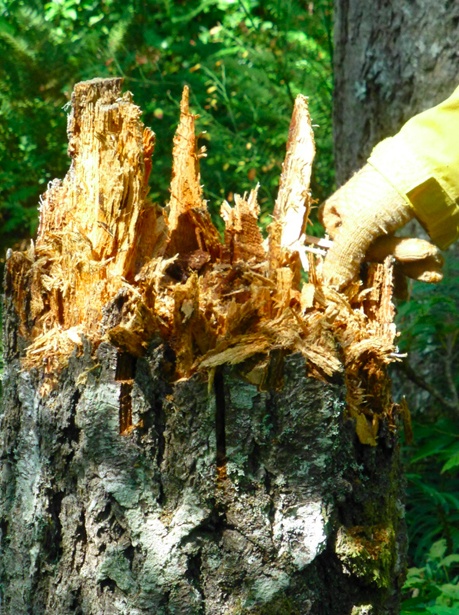By Ken Bevis,
DNR Stewardship Wildlife Biologist
Reprinted with permission of the Washington DNR
In the forest, trees exist in many phases simultaneously, from seedlings to giants, and then as standing dead trees (snags) and down logs. Dead trees are an essential part of forest ecology.
Well over 100 species of wildlife in Pacific Northwest forests depend on dead wood for crucial habitat. Woodpeckers, songbirds, squirrels, salamanders and owls use these woody structures as places to feed, and as cover.
“Wildlife tree” refers to trees with dead wood features (holes, cracks, loose bark) providing habitats for cavity-dwelling species. Nearly one-third of forest wildlife species must have some form of “wildlife trees” on their home range for survival.
The best natural wildlife tree may be a broken off snag, with adequate height and diameter to meet multiple habitat needs.
People actively cut trees across the landscape for many reasons. Rather than always removing whole trees, arborists and loggers can easily create long-lived, high quality wildlife trees by shortening (“topping”) the tree, then leaving the stem for weather and woodpeckers to do their work creating habitat.
Tim Brown of Snoqualmie is a pioneer in wildlife tree creation. He started making wildlife trees in the 1970s when working first as a logger, arborist, and then as a forest firefighter. He has a lifelong love for wildlife, and noticed many animals fleeing from fallen snags while he was falling timber.
“I started thinking about it and would come home and make wildlife trees. I started in gardens and with landscape trees.” he said.
His business, Frontier Tree Service, near Lake Sammamish, created wildlife trees which still stand in national parks, refuges, forests and greenbelts throughout the Northwest.
We went to a private property near Snoqualmie for this article.
Selecting the ‘right’ Tree
Trees to be made into wildlife trees should be solid enough to be worked, either by a qualified tree climber or someone in a bucket truck. They also should be a long-lived species, in a location where future safety issues or development won’t require cutting. Brown recommends conifers, particularly Douglas fir, cedar or ponderosa pine, as they tend to last longer. However, all species can function as wildlife trees.
We identified a clump of Douglas fir, recently dead, approximately 24″ in diameter and sound enough to climb.
Brown ascended the tree with climbing gear, cut off the top about 45 feet up, and used a chainsaw to create a jagged top.
The overall height of the wildlife tree should be less than the distance to a target, unless there is very little traffic. The shortened tree will have little weight on the top, so is unlikely to simply topple over. In general, wildlife tree stubs fall apart in place over many years rather than falling over.
How much of the trunk to remove when creating a wildlife tree?
“We want the tree to stay up as long as possible,” says Brown, who recommends assessing potential trees for lean, overall stability and sway. In general, the larger the diameter, the better. The top diameter of cut trees should be at least 6 inches.
Trees are generally cut to one or two thirds of their height, 25 to 60 feet. Most branches are removed, with some stubs retained when possible.
“Sometimes I’ll leave some green branches so the tree dies slowly and remains stable longer,” notes Brown. Causing the tree to die slowly allows its still-living roots to hold it up longer.
The top of the tree should be “roughed up” with a chainsaw. Make a series of v-shaped cuts across the top, then crisscross those with the saw from multiple horizontal angles.
“The top is jagged to better collect moisture and organic matter. Make it slightly concave in the middle to collect water,” Brown said.
He also makes a few deep vertical cuts down into the stem at the top to help introduce water and rot.
This article originally appeared in the fall 2016 Forest Stewardship Notes, a quarterly online newsletter.



